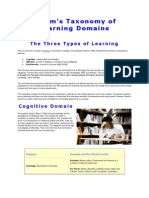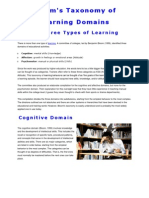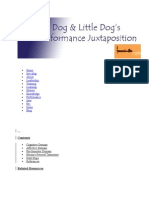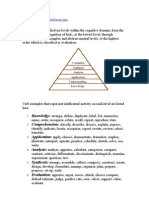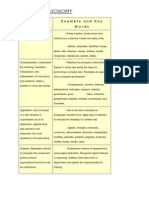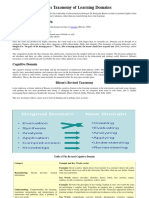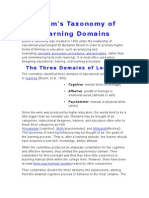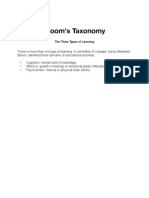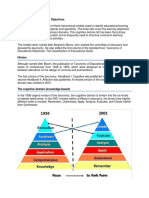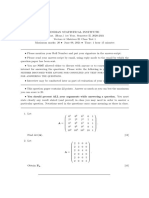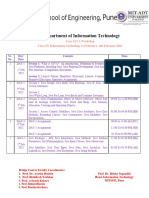Bloom's Taxonomy of Learning Domains
Bloom's Taxonomy of Learning Domains
Uploaded by
Sakura MyristicCopyright:
Available Formats
Bloom's Taxonomy of Learning Domains
Bloom's Taxonomy of Learning Domains
Uploaded by
Sakura MyristicOriginal Title
Copyright
Available Formats
Share this document
Did you find this document useful?
Is this content inappropriate?
Copyright:
Available Formats
Bloom's Taxonomy of Learning Domains
Bloom's Taxonomy of Learning Domains
Uploaded by
Sakura MyristicCopyright:
Available Formats
Bloom's Taxonomy of Learning Domains
The Three Types of Learning
There is more than one type of learning. A committee of colleges, led by Benjamin Bloom (1956), identified three domains of educational activities:
o o o
Cognitive: mental skills (Knowledge) Affective: growth in feelings or emotional areas (Attitude) Psychomotor: manual or physical skills (Skills)
Since the work was produced by higher education, the words tend to be a little bigger than we normally use. Domains can be thought of as categories. Trainers often refer to these three categories as KSA (Knowledge, Skills, and Attitude). This taxonomy of learning behaviors can be thought of as the goals of the learning process. That is, after a learning episode, the learner should have acquired new skills, knowledge, and/or attitudes. The committee also produced an elaborate compilation for the cognitive and affective domains, but none for the psychomotor domain. Their explanation for this oversight was that they have little experience in teaching manual skills within the college level (I guess they never thought to check with their sports or drama departments). This compilation divides the three domains into subdivisions, starting from the simplest behavior to the most complex. The divisions outlined are not absolutes and there are other systems or hierarchies that have been devised in the educational and training world. However, Bloom's taxonomy is easily understood and is probably the most widely applied one in use today.
Cognitive Domain
The cognitive domain (Bloom, 1956) involves knowledge and the development of intellectual skills. This includes the recall or recognition of specific facts, procedural patterns, and concepts that serve in the development of intellectual abilities and skills. There are six major categories, which are listed in order below, starting from the simplest behavior to the most complex. The categories can be thought of as degrees of difficulties. That is, the first ones must normally be mastered before the next ones can take place.
Category
Example and Key Words (verbs)
Examples: Recite a policy. Quote prices from memory to a customer. Knows the safety rules.
Knowledge: Recall data or information.
Key Words: defines, describes, identifies, knows, labels, lists, matches, names, outlines, recalls, recognizes, reproduces, selects, states.
Comprehension: Understand the meaning, translation, interpolation, and interpretation of instructions and problems. State a problem in one's own words.
Examples: Rewrites the principles of test writing. Explain in one's own words the steps for performing a complex task. Translates an equation into a computer spreadsheet. Key Words: comprehends, converts, defends, distinguishes, estimates, explains, extends, generalizes, gives an example, infers, interprets, paraphrases, predicts, rewrites, summarizes, translates. Examples: Use a manual to calculate an employee's vacation time. Apply laws of statistics to evaluate the reliability of a written test. Key Words: applies, changes, computes, constructs, demonstrates, discovers, manipulates, modifies, operates, predicts, prepares, produces, relates, shows, solves, uses. Examples: Troubleshoot a piece of equipment by using logical deduction. Recognize logical fallacies in reasoning. Gathers information from a department and selects the required tasks for training. Key Words: analyzes, breaks down, compares, contrasts, diagrams, deconstructs, differentiates, discriminates, distinguishes, identifies, illustrates, infers, outlines, relates, selects, separates. Examples: Write a company operations or process manual. Design a machine to perform a specific task. Integrates training from several sources to solve a problem. Revises and process to improve the outcome. Key Words: categorizes, combines, compiles, composes, creates, devises, designs, explains, generates, modifies, organizes, plans, rearranges, reconstructs, relates, reorganizes, revises, rewrites, summarizes, tells, writes. Examples: Select the most effective solution. Hire the most qualified candidate. Explain and justify a new budget.
Application: Use a concept in a new situation or unprompted use of an abstraction. Applies what was learned in the classroom into novel situations in the work place.
Analysis: Separates material or concepts into component parts so that its organizational structure may be understood. Distinguishes between facts and inferences.
Synthesis: Builds a structure or pattern from diverse elements. Put parts together to form a whole, with emphasis on creating a new meaning or structure.
Evaluation: Make judgments about the value of ideas or materials.
Key Words: appraises, compares, concludes, contrasts, criticizes, critiques, defends, describes, discriminates, evaluates, explains, interprets, justifies, relates, summarizes, supports.
Affective Domain
The affective domain (Krathwohl, Bloom, Masia, 1973) includes the manner in which we deal with things emotionally, such as feelings, values, appreciation, enthusiasms, motivations, and attitudes. The five major categories are listed from the simplest behavior to the most complex:
Category
Example and Key Words (verbs)
Examples: Listen to others with respect. Listen for and remember the name of newly introduced people. Key Words: asks, chooses, describes, follows, gives, holds, identifies, locates, names, points to, selects, sits, erects, replies, uses. Examples: Participates in class discussions. Gives a presentation. Questions new ideals, concepts, models, etc. in order to fully understand them. Know the safety rules and practices them. Key Words: answers, assists, aids, complies, conforms, discusses, greets, helps, labels, performs, practices, presents, reads, recites, reports, selects, tells, writes. Examples: Demonstrates belief in the democratic process. Is sensitive towards individual and cultural differences (value diversity). Shows the ability to solve problems. Proposes a plan to social improvement and follows through with commitment. Informs management on matters that one feels strongly about. Key Words: completes, demonstrates, differentiates, explains, follows, forms, initiates, invites, joins, justifies, proposes, reads, reports, selects, shares, studies, works. Examples: Recognizes the need for balance between freedom and responsible behavior. Accepts responsibility for one's behavior. Explains the role of systematic planning in solving problems. Accepts professional ethical standards. Creates a life plan in harmony with abilities, interests, and beliefs. Prioritizes time effectively to meet the needs of the organization, family, and self. Key Words: adheres, alters, arranges, combines, compares, completes, defends, explains, formulates, generalizes, identifies, integrates, modifies, orders, organizes, prepares, relates, synthesizes.
Receiving Phenomena: Awareness, willingness to hear, selected attention.
Responding to Phenomena: Active participation on the part of the learners. Attends and reacts to a particular phenomenon. Learning outcomes may emphasize compliance in responding, willingness to respond, or satisfaction in responding (motivation).
Valuing: The worth or value a person attaches to a particular object, phenomenon, or behavior. This ranges from simple acceptance to the more complex state of commitment. Valuing is based on the internalization of a set of specified values, while clues to these values are expressed in the learner's overt behavior and are often identifiable.
Organization: Organizes values into priorities by contrasting different values, resolving conflicts between them, and creating an unique value system. The emphasis is on comparing, relating, and synthesizing values.
Internalizing values (characterization): Has a
Examples: Shows self-reliance when working
value system that controls their behavior. The behavior is pervasive, consistent, predictable, and most importantly, characteristic of the learner. Instructional objectives are concerned with the student's general patterns of adjustment (personal, social, emotional).
independently. Cooperates in group activities (displays teamwork). Uses an objective approach in problem solving. Displays a professional commitment to ethical practice on a daily basis. Revises judgments and changes behavior in light of new evidence. Values people for what they are, not how they look. Key Words: acts, discriminates, displays, influences, listens, modifies, performs, practices, proposes, qualifies, questions, revises, serves, solves, verifies.
Psychomotor Domain
The psychomotor domain (Simpson, 1972) includes physical movement, coordination, and use of the motor-skill areas. Development of these skills requires practice and is measured in terms of speed, precision, distance, procedures, or techniques in execution. The seven major categories are listed from the simplest behavior to the most complex:
Category
Example and Key Words (verbs)
Examples: Detects non-verbal communication cues. Estimate where a ball will land after it is thrown and then moving to the correct location to catch the ball. Adjusts heat of stove to correct temperature by smell and taste of food. Adjusts the height of the forks on a forklift by comparing where the forks are in relation to the pallet. Key Words: chooses, describes, detects, differentiates, distinguishes, identifies, isolates, relates, selects. Examples: Knows and acts upon a sequence of steps in a manufacturing process. Recognize one's abilities and limitations. Shows desire to learn a new process (motivation). NOTE: This subdivision of Psychomotor is closely related with the Responding to phenomena subdivision of the Affective domain. Key Words: begins, displays, explains, moves, proceeds, reacts, shows, states, volunteers. Examples: Performs a mathematical equation as demonstrated. Follows instructions to build a model. Responds hand-signals of instructor while learning to operate a forklift. Key Words: copies, traces, follows, react,
Perception: The ability to use sensory cues to guide motor activity. This ranges from sensory stimulation, through cue selection, to translation.
Set: Readiness to act. It includes mental, physical, and emotional sets. These three sets are dispositions that predetermine a person's response to different situations (sometimes called mindsets).
Guided Response: The early stages in learning a complex skill that includes imitation and trial and error. Adequacy of performance is achieved by practicing.
reproduce, responds Examples: Use a personal computer. Repair a leaking faucet. Drive a car. Key Words: assembles, calibrates, constructs, dismantles, displays, fastens, fixes, grinds, heats, manipulates, measures, mends, mixes, organizes, sketches. Examples: Maneuvers a car into a tight parallel parking spot. Operates a computer quickly and accurately. Displays competence while playing the piano. Key Words: assembles, builds, calibrates, constructs, dismantles, displays, fastens, fixes, grinds, heats, manipulates, measures, mends, mixes, organizes, sketches. NOTE: The Key Words are the same as Mechanism, but will have adverbs or adjectives that indicate that the performance is quicker, better, more accurate, etc. Examples: Responds effectively to unexpected experiences. Modifies instruction to meet the needs of the learners. Perform a task with a machine that it was not originally intended to do (machine is not damaged and there is no danger in performing the new task). Key Words: adapts, alters, changes, rearranges, reorganizes, revises, varies. Examples: Constructs a new theory. Develops a new and comprehensive training programming. Creates a new gymnastic routine. Key Words: arranges, builds, combines, composes, constructs, creates, designs, initiate, makes, originates.
Mechanism: This is the intermediate stage in learning a complex skill. Learned responses have become habitual and the movements can be performed with some confidence and proficiency.
Complex Overt Response: The skillful performance of motor acts that involve complex movement patterns. Proficiency is indicated by a quick, accurate, and highly coordinated performance, requiring a minimum of energy. This category includes performing without hesitation, and automatic performance. For example, players are often utter sounds of satisfaction or expletives as soon as they hit a tennis ball or throw a football, because they can tell by the feel of the act what the result will produce.
Adaptation: Skills are well developed and the individual can modify movement patterns to fit special requirements.
Origination: Creating new movement patterns to fit a particular situation or specific problem. Learning outcomes emphasize creativity based upon highly developed skills.
Other Psychomotor Domain Taxonomies
As mentioned earlier, the committee did not produce a compilation for the psychomotor domain model, but others have. The one discussed above is by Simpson (1972). There are two other popular versions: Dave's (1975):
Imitation Observing and patterning behavior after someone else. Performance may be of low quality. Example: Copying a work of art.
o o o o
Manipulation Being able to perform certain actions by following instructions and practicing. Example: Creating work on one's own, after taking lessons, or reading about it. Precision Refining, becoming more exact. Few errors are apparent. Example: Working and reworking something, so it will be just right. Articulation Coordinating a series of actions, achieving harmony and internal consistency. Example: Producing a video that involves music, drama, color, sound, etc. Naturalization Having high level performance become natural, without needing to think much about it. Examples: Michael Jordan playing basketball, Nancy Lopez hitting a golf ball, etc.
Harrow's (1972):
o o o o o o
Reflex movements Reactions that are not learned. Fundamental movements Basic movements such as walking, or grasping. Perception Response to stimuli such as visual, auditory, kinesthetic, or tactile discrimination. Physical abilities Stamina that must be developed for further development such as strength and agility. Skilled movements Advanced learned movements as one would find in sports or acting. No discursive communication Effective body language, such as gestures and facial expressions.
Bloom's Revised Taxonomy
Lorin Anderson, a former student of Bloom, revisited the cognitive domain in the learning taxonomy in the midnineties and made some changes, with perhaps the two most prominent ones being, 1) changing the names in the six categories from noun to verb forms, and 2) slightly rearranging them (Pohl, 2000). This new taxonomy reflects a more active form of thinking and is perhaps more accurate:
Category
Example and Key Words (verbs)
Examples: Recite a policy. Quote prices from memory to a customer. Knows the safety rules.
Remembering: Recall previous learned information.
Key Words: defines, describes, identifies, knows, labels, lists, matches, names, outlines, recalls, recognizes, reproduces, selects, states. Examples: Rewrites the principles of test writing. Explain in one's own words the steps for performing a complex task. Translates an equation into a computer spreadsheet. Key Words: comprehends, converts, defends, distinguishes, estimates, explains, extends, generalizes, gives an example, infers, interprets, paraphrases, predicts, rewrites, summarizes, translates. Examples: Use a manual to calculate an employee's vacation time. Apply laws of statistics to evaluate the reliability of a written test. Key Words: applies, changes, computes, constructs, demonstrates, discovers, manipulates, modifies, operates, predicts, prepares, produces, relates, shows, solves, uses. Examples: Troubleshoot a piece of equipment by using logical deduction. Recognize logical fallacies in reasoning. Gathers information from a department and selects the required tasks for training. Key Words: analyzes, breaks down, compares, contrasts, diagrams, deconstructs, differentiates, discriminates, distinguishes, identifies, illustrates, infers, outlines, relates, selects, separates. Examples: Select the most effective solution. Hire the most qualified candidate. Explain and justify a new budget.
Understanding: Comprehending the meaning, translation, interpolation, and interpretation of instructions and problems. State a problem in one's own words.
Applying: Use a concept in a new situation or unprompted use of an abstraction. Applies what was learned in the classroom into novel situations in the work place.
Analyzing: Separates material or concepts into component parts so that its organizational structure may be understood. Distinguishes between facts and inferences.
Evaluating: Make judgments about the value of ideas or materials.
Key Words: appraises, compares, concludes, contrasts, criticizes, critiques, defends, describes, discriminates, evaluates, explains, interprets, justifies, relates, summarizes, supports. Examples: Write a company operations or process manual. Design a machine to perform a specific task. Integrates training from several sources to solve a problem. Revises and process to improve the outcome.
Creating: Builds a structure or pattern from diverse elements. Put parts together to form a whole, with emphasis on creating a new meaning or structure.
Key Words: categorizes, combines, compiles, composes, creates, devises, designs, explains, generates, modifies, organizes, plans, rearranges, reconstructs, relates, reorganizes, revises, rewrites, summarizes, tells, writes.
You might also like
- Case-5 2Document10 pagesCase-5 2Junghoon YangPark67% (3)
- Organisational StructureDocument18 pagesOrganisational StructureAmmy D Extrovert73% (11)
- How To Construct A Table of SpecificationDocument48 pagesHow To Construct A Table of SpecificationPearl Marie Guilaran Palma82% (11)
- Taxonomy of Educational ObjectivesDocument13 pagesTaxonomy of Educational ObjectivesEmelia GhiLe Cericos100% (2)
- Brandin LeBlanc - Revised PDFDocument3 pagesBrandin LeBlanc - Revised PDFvrb1260% (3)
- Bloom's Taxonomy of Learning DomainsDocument5 pagesBloom's Taxonomy of Learning Domainsthanu_2010No ratings yet
- Bloom's TaxonomyDocument19 pagesBloom's TaxonomyZubair KhanNo ratings yet
- Bloom's Taxonomy of Learning DomainsDocument10 pagesBloom's Taxonomy of Learning DomainsKellor NiohNo ratings yet
- Bloom's Taxonomy of Learning DomainsDocument10 pagesBloom's Taxonomy of Learning DomainsJose JosephNo ratings yet
- Bloom's Taxonomy of Learning DomainsDocument9 pagesBloom's Taxonomy of Learning Domainsvansick007No ratings yet
- Bloom's TaxonomyDocument8 pagesBloom's TaxonomyNoridah YusofNo ratings yet
- Home Site Map About Leadership Training Learning History Knowledge Performance Java Etc. News BlogDocument13 pagesHome Site Map About Leadership Training Learning History Knowledge Performance Java Etc. News BlogJoann Plaza ReforminaNo ratings yet
- Learning Domains or BloomDocument11 pagesLearning Domains or Bloomakuadalah308No ratings yet
- Learning Domains or Bloom's Taxonomy: T He Three Types of LearningDocument7 pagesLearning Domains or Bloom's Taxonomy: T He Three Types of LearningRisnantoganto SutarsoNo ratings yet
- Bloom Taxonomy of LearningDocument9 pagesBloom Taxonomy of LearningDavid BartonNo ratings yet
- Bloom's Taxonomy of Learning DomainsDocument10 pagesBloom's Taxonomy of Learning DomainsEduardo EdwaNo ratings yet
- Bloom'S Taxonomy of Learning DomainsDocument31 pagesBloom'S Taxonomy of Learning DomainsrometimbaNo ratings yet
- Bloom's Taxonomy of Learning DomainsDocument5 pagesBloom's Taxonomy of Learning DomainsHeksi Putri SutrisnoNo ratings yet
- Blooms TaxonomyDocument13 pagesBlooms Taxonomyapi-382387880% (5)
- The Three Types of Learning by BloomDocument8 pagesThe Three Types of Learning by BloomRosevil Egpit AlinNo ratings yet
- All 3 Blooms 2015Document4 pagesAll 3 Blooms 2015Lenie Sang-olanNo ratings yet
- The Cognitive Domain Involves Knowledge and The Development of Intellectual SkillsDocument12 pagesThe Cognitive Domain Involves Knowledge and The Development of Intellectual SkillsChristian Edezon LopezNo ratings yet
- Bloom's Taxonomy of Learning: Cognitive DomainDocument13 pagesBloom's Taxonomy of Learning: Cognitive Domainmanu_nehaNo ratings yet
- Blooms TaxonomyDocument7 pagesBlooms Taxonomyutello100% (2)
- Learning Domains or Bloom's Taxonomy: The Three Types of LearningDocument8 pagesLearning Domains or Bloom's Taxonomy: The Three Types of Learningamber ariaNo ratings yet
- Blooms Taxonomy of Learning Domains The PDFDocument12 pagesBlooms Taxonomy of Learning Domains The PDFLin Coloma Viernes WagayenNo ratings yet
- Cognitive Domain: Hidayatul Syaheeda Mohd Isa DPLI-SejarahDocument7 pagesCognitive Domain: Hidayatul Syaheeda Mohd Isa DPLI-SejarahNor AzimahNo ratings yet
- Teacher Training Program 2018 02-03 July, 2018: The Three Types of LearningDocument8 pagesTeacher Training Program 2018 02-03 July, 2018: The Three Types of LearningUmar HamidNo ratings yet
- Seminar On Table of Specs (TOS)Document39 pagesSeminar On Table of Specs (TOS)Paulo Israel Escobal RemulloNo ratings yet
- Bloom'S Taxonomy of Learning DomainsDocument27 pagesBloom'S Taxonomy of Learning DomainsKiran KhasaNo ratings yet
- Bloom's Taxonomy of Learning DomainsDocument15 pagesBloom's Taxonomy of Learning DomainsFizza RaufNo ratings yet
- Bloom's Taxonomy of Learning DomainsDocument6 pagesBloom's Taxonomy of Learning Domainsikhmar6697No ratings yet
- Blooms TaxonomyDocument6 pagesBlooms TaxonomyRaji PanduranganNo ratings yet
- Bloom'S - Taxonomy - PPT AbidaDocument42 pagesBloom'S - Taxonomy - PPT AbidaBinyamin aurangzaibNo ratings yet
- Blooms Taxonomy ResourcesDocument5 pagesBlooms Taxonomy ResourcesloganNo ratings yet
- CTR FinalDocument42 pagesCTR Finalmaria tabassumNo ratings yet
- Safari - 23 Oct 2018 at 7:07 AM PDFDocument1 pageSafari - 23 Oct 2018 at 7:07 AM PDFhr187No ratings yet
- Blooms Domains 2Document9 pagesBlooms Domains 2Cherry-Ann C. OlajayNo ratings yet
- Cognitive Domain: Cooperative LearningDocument5 pagesCognitive Domain: Cooperative LearningGlaiden MaryNo ratings yet
- Topic 14 Educational PsyDocument41 pagesTopic 14 Educational Psywalelign mitikuNo ratings yet
- 4 - Domains of LearningDocument6 pages4 - Domains of LearningRikka Jelleanna PalasanNo ratings yet
- The Three Types of LearningDocument10 pagesThe Three Types of Learningmary heart baldemoroNo ratings yet
- Bloom TaxonomyDocument9 pagesBloom Taxonomyapi-256334406100% (2)
- Bloom's Taxonomy: Cognitive Domain (Knowledge-Based), Original VersionDocument6 pagesBloom's Taxonomy: Cognitive Domain (Knowledge-Based), Original VersionRein MagaroNo ratings yet
- Six LevelsDocument10 pagesSix LevelsBlesilda MallillinNo ratings yet
- Edit Source: CognitiveDocument4 pagesEdit Source: CognitiveBenjie Modelo ManilaNo ratings yet
- Domains Bloom's Taxonomy of LearningDocument20 pagesDomains Bloom's Taxonomy of LearningNhil Cabillon QuietaNo ratings yet
- Blooms TaxonomyDocument16 pagesBlooms TaxonomyChristine Navarro-De RoxasNo ratings yet
- Blooms TaxonomyDocument36 pagesBlooms TaxonomyMuniba ArshadNo ratings yet
- Bloom's Taxonomy: The Three Types of LearningDocument19 pagesBloom's Taxonomy: The Three Types of Learningiq_mzj9892No ratings yet
- Bloom's TaxonomyDocument5 pagesBloom's TaxonomyRivanda DebiNo ratings yet
- Bloom's Taxonomy - WikipediaDocument10 pagesBloom's Taxonomy - WikipediaHarshal VaidyaNo ratings yet
- Quintana Phases of LearningDocument28 pagesQuintana Phases of LearningDaisy Joyce TorresNo ratings yet
- Blooms Taxonomy Learning DomainsDocument4 pagesBlooms Taxonomy Learning Domainskeithrabino.0926No ratings yet
- Bloom's TaxonomyDocument9 pagesBloom's TaxonomyIsrahana Shahril100% (1)
- Learning and Bloom's Taxonomy Learning Goals and OutcomesDocument2 pagesLearning and Bloom's Taxonomy Learning Goals and OutcomesVera MillerNo ratings yet
- Taxonomy of Educational Objectives OutlineDocument9 pagesTaxonomy of Educational Objectives OutlineRexonChanNo ratings yet
- Tugas 4Document6 pagesTugas 4Widiayu SeptianiNo ratings yet
- Bloom's of TaxonomyDocument24 pagesBloom's of TaxonomyMelinda Cariño ChavezNo ratings yet
- Narrative Writing SlideDocument6 pagesNarrative Writing SlideMPuga TiyagaNo ratings yet
- Bloom's TaxonomyDocument35 pagesBloom's TaxonomySaleem RazaNo ratings yet
- Dimacs08 2Document41 pagesDimacs08 2SRAJAL DWIVEDINo ratings yet
- IIT JEE Coordinate Geometry - Preparation Tips To Practical Applications! - askIITiansDocument19 pagesIIT JEE Coordinate Geometry - Preparation Tips To Practical Applications! - askIITiansaskiitian67% (3)
- Chemistry 1 - ExamDocument6 pagesChemistry 1 - Examnassorussi9No ratings yet
- Est MicroprojectDocument14 pagesEst Microprojectsdargopatil11No ratings yet
- Introduction To Apsimng - The Gtksharp User Interface For ApsimxDocument3 pagesIntroduction To Apsimng - The Gtksharp User Interface For ApsimxMarceloNo ratings yet
- Surface Miner 2200 SM: Technical SpecificationDocument9 pagesSurface Miner 2200 SM: Technical SpecificationNitesh JainNo ratings yet
- Examples of Compare and Contrast Essay Thesis StatementsDocument7 pagesExamples of Compare and Contrast Essay Thesis Statementsgbww46x7100% (1)
- Trading Tips - Big Book of Chart Patterns-Riddler (2019) - OrgDocument109 pagesTrading Tips - Big Book of Chart Patterns-Riddler (2019) - OrgLandrio MavericksNo ratings yet
- 6_Lecture _6_(Regular)Document6 pages6_Lecture _6_(Regular)As ChNo ratings yet
- Fractions Final ProjectDocument10 pagesFractions Final Projectapi-291564354No ratings yet
- CT 1Document1 pageCT 1amarjeet kumarNo ratings yet
- Cooper Deadbreak Elbow 55010Document4 pagesCooper Deadbreak Elbow 55010denzil_1000No ratings yet
- Comparitive On Cock and Health DrinksDocument45 pagesComparitive On Cock and Health Drinksप्रशांत कुमारNo ratings yet
- 2020 Business PlanDocument86 pages2020 Business PlanbaabdullahNo ratings yet
- A Summer Internship Project Report On: Submitted ToDocument63 pagesA Summer Internship Project Report On: Submitted Torahul kumarNo ratings yet
- Gbi Project - Sonic Tower OfficeDocument35 pagesGbi Project - Sonic Tower OfficeHazrul AimanNo ratings yet
- Single User, Multi-User and Network Os, Izuchukwu Nwankpa, 2019516015PBDocument8 pagesSingle User, Multi-User and Network Os, Izuchukwu Nwankpa, 2019516015PBnwankpa izuchukwu victorNo ratings yet
- AKTU Admit CardDocument3 pagesAKTU Admit CardDevesh Kr PathakNo ratings yet
- Categorising Lifting Operations PDFDocument2 pagesCategorising Lifting Operations PDFpreventing becejNo ratings yet
- Grade 3 Math: 3.NF.3d Day 14Document18 pagesGrade 3 Math: 3.NF.3d Day 14Apichartj JusuayNo ratings yet
- WinRM Penetration TestingDocument21 pagesWinRM Penetration TestingdonybelliniNo ratings yet
- General Information: Section 0Document33 pagesGeneral Information: Section 0Ryan EncomiendaNo ratings yet
- Cry of Pugadlawin: Excalibur Ray V. PalaciosDocument12 pagesCry of Pugadlawin: Excalibur Ray V. PalaciosAngelica Jasmin MagbanuaNo ratings yet
- Business Process Improvement PlanDocument14 pagesBusiness Process Improvement Plansonia_soja100% (3)
- JAVA Bridge Course Contents and ScheduleDocument1 pageJAVA Bridge Course Contents and SchedulePranav PadwaleNo ratings yet
- Year 2 Assessment Reasoning Autumn 2018Document16 pagesYear 2 Assessment Reasoning Autumn 2018Ayesha AliNo ratings yet
- Me GleeDocument1 pageMe Gleeapi-320989731No ratings yet





